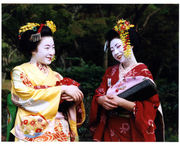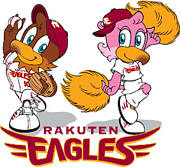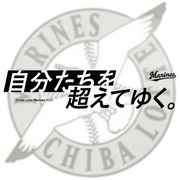通訳案内士(通訳ガイド)試験受験対策<2008年度英語第2次試験の模範解答例(その4)>
━━━━━━━━━━━━━━━━━━━━━━━━━━━━
2008年度英語第2次試験の時間帯別問題群(7)と模範解答例
━━━━━━━━━━━━━━━━━━━━━━━━━━━━
●問題群(7)[16:00〜17:30]
(1)うどんとそばの違いを説明せよ。
What is the difference between udon and soba?
Soba are long, thin brownish noodles made from buckwheat flour mixed with wheat flour, egg and yam starch. Udon are white noodles made from wheat flour, and are thicker than soba. Both are eaten either hot in a soup or as a cold dish with a dipping sauce.
(2)平安時代を説明せよ。
What was the Heian period like? Tell us about the Heian period.
The Heian period spanned the time from the transfer of the capital from Nagaoka to Kyoto in 794 until Minamoto-no-Yoritomo’s establishment of his shogunate government in 1192. Emperors, aristocrats like the Fujiwara family, and retired emperors ruled for a large part of this period. This period saw the development of arts and literature of courtly elegance and refinement, as exemplified in the novel “The Tale of Genji.”
(3)日本人は神社で何故柏手を打つのか。
Why do Japanese people clap their hands at Shinto shrines?
Clapping hands in front of a Shinto shrine is often misinterpreted to mean that the worshiper wishes to call the attention of kami, or the Shinto god. Historically speaking, however, clapping hands is an ancient form of paying respect in Japan. In ancient times, people clapped their hands at ceremonies held at the Imperial Court or when receiving a gift from a person in a high position. Therefore, by clapping hands before a Shinto shrine or altar, the worshiper is paying respect to the deity.
(4)日本の蒸し暑い夏をどう過ごすのか。
I hear that in Japan it is very hot and humid in summer. How do you cope with it?
During very hot, humid summers, I sometimes spend evenings or holidays with a yukata on. Yukata is an informal thin cotton kimono, and it is very relaxing to be in, especially on hot days. Also, our family often waters our yard to cool the air that comes into our house, and hangs a “furin” under the eaves. Furin is a wind chime made of metal, porcelain, or glass, and when it catches the summer breezes, it makes a nice soothing sound, which makes me feel better.
(5)京都と奈良に神社仏閣が多い理由は何か。
Why are there so many shrines and temples in Kyoto and Nara?
Both Kyoto and Nara were once the ancient capitals of Japan. During the Nara period, successive emperors hoped to pacify the nation through embracing Buddhism as a state religion. Kyoto had been the capital for more than 1,000 years, and many emperors believed in Buddhism. As for shrines, the reason for existence of the Japanese imperial family is based on the Shinto tenet that emperors are the descendants of the sun goddess Amaterasu. For these reasons, many emperors sponsored the building of shrines and temples in the two ancient capitals.
(6)新幹線に乗り遅れたらどうするのか。
What would you do, if a group of foreign tourists you are guiding missed the Shinkansen they were supposed to take?
I would tell them not to worry. The Shinkansen trains run quite often. In the case of the Tokaido Shinkansen Line, the super- express trains run every 10 minutes or even more often. So we can take the next train and get an unreserved seat using the same ticket of ours.
(7)何故、あなたは通訳ガイドになりたいのですか?
Why do you want to be a tour guide?
━━━━━━━━━━━━━━━━
●<ハローの合格必勝教材>のお申込み:
http://
━━━━━━━━━━━━━━━━
━━━━━━━━━━━━━━━━━━━━━━━━━━━━
2008年度英語第2次試験の時間帯別問題群(7)と模範解答例
━━━━━━━━━━━━━━━━━━━━━━━━━━━━
●問題群(7)[16:00〜17:30]
(1)うどんとそばの違いを説明せよ。
What is the difference between udon and soba?
Soba are long, thin brownish noodles made from buckwheat flour mixed with wheat flour, egg and yam starch. Udon are white noodles made from wheat flour, and are thicker than soba. Both are eaten either hot in a soup or as a cold dish with a dipping sauce.
(2)平安時代を説明せよ。
What was the Heian period like? Tell us about the Heian period.
The Heian period spanned the time from the transfer of the capital from Nagaoka to Kyoto in 794 until Minamoto-no-Yoritomo’s establishment of his shogunate government in 1192. Emperors, aristocrats like the Fujiwara family, and retired emperors ruled for a large part of this period. This period saw the development of arts and literature of courtly elegance and refinement, as exemplified in the novel “The Tale of Genji.”
(3)日本人は神社で何故柏手を打つのか。
Why do Japanese people clap their hands at Shinto shrines?
Clapping hands in front of a Shinto shrine is often misinterpreted to mean that the worshiper wishes to call the attention of kami, or the Shinto god. Historically speaking, however, clapping hands is an ancient form of paying respect in Japan. In ancient times, people clapped their hands at ceremonies held at the Imperial Court or when receiving a gift from a person in a high position. Therefore, by clapping hands before a Shinto shrine or altar, the worshiper is paying respect to the deity.
(4)日本の蒸し暑い夏をどう過ごすのか。
I hear that in Japan it is very hot and humid in summer. How do you cope with it?
During very hot, humid summers, I sometimes spend evenings or holidays with a yukata on. Yukata is an informal thin cotton kimono, and it is very relaxing to be in, especially on hot days. Also, our family often waters our yard to cool the air that comes into our house, and hangs a “furin” under the eaves. Furin is a wind chime made of metal, porcelain, or glass, and when it catches the summer breezes, it makes a nice soothing sound, which makes me feel better.
(5)京都と奈良に神社仏閣が多い理由は何か。
Why are there so many shrines and temples in Kyoto and Nara?
Both Kyoto and Nara were once the ancient capitals of Japan. During the Nara period, successive emperors hoped to pacify the nation through embracing Buddhism as a state religion. Kyoto had been the capital for more than 1,000 years, and many emperors believed in Buddhism. As for shrines, the reason for existence of the Japanese imperial family is based on the Shinto tenet that emperors are the descendants of the sun goddess Amaterasu. For these reasons, many emperors sponsored the building of shrines and temples in the two ancient capitals.
(6)新幹線に乗り遅れたらどうするのか。
What would you do, if a group of foreign tourists you are guiding missed the Shinkansen they were supposed to take?
I would tell them not to worry. The Shinkansen trains run quite often. In the case of the Tokaido Shinkansen Line, the super- express trains run every 10 minutes or even more often. So we can take the next train and get an unreserved seat using the same ticket of ours.
(7)何故、あなたは通訳ガイドになりたいのですか?
Why do you want to be a tour guide?
━━━━━━━━━━━━━━━━
●<ハローの合格必勝教材>のお申込み:
http://
━━━━━━━━━━━━━━━━
|
|
|
|
|
|
|
|
通訳案内士は民間外交官! 更新情報
-
最新のアンケート
通訳案内士は民間外交官!のメンバーはこんなコミュニティにも参加しています
人気コミュニティランキング
- 1位
- 楽天イーグルス
- 31948人
- 2位
- 千葉 ロッテマリーンズ
- 37152人
- 3位
- 一行で笑わせろ!
- 82528人
























